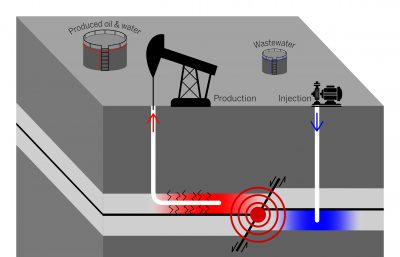Production Pressure
November 12, 2020

The connection between oil and gas production and induced earthquakes is a hot research topic, with scientists studying which parts of the process are associated with increasing earthquake hazards.
While recent studies have shown that underground disposal of saltwater, a byproduct of oil and gas extraction, can increase the risk of earthquakes by raising pressure on nearby faults, the production of the oil and gas itself has been generally thought to lower that risk by relieving pressure.
But a study led by the Bureau of Economic Geology is challenging that thought. The study found that producing oil and gas from unconventional shale reservoirs near a fault could increase earthquake hazards by changing the stress felt by the fault.
According to the authors, their study illustrates the need to consider both disposal and production, and how the combined effects can influence earthquake hazards.
“It’s not so simple to blame saltwater disposal in isolation. We can’t ignore the effects of production,” said Peter Eichhubl, a senior research scientist at the bureau.
The study was published Jan. 30, 2020, in the journal Geomechanics for Energy and the Environment. The authors are Eichhubl and bureau postdoctoral fellow Mahdi Haddad.
The research is based on a computational model of a simplified unconventional reservoir. The model allowed the researchers to track the stress changes on a fault as oil and gas were extracted from a shale layer and saltwater was disposed of in a different layer, an operations scenario known as a stacked reservoir.
In conventional oil and gas operations, the saltwater produced alongside oil and gas is disposed of by injecting it back into the same layer where the hydrocarbons were extracted, which helps stabilize pressure within the surrounding rock. In a stacked reservoir, the produced saltwater must be placed in a different, more porous rock layer because shale is unable to absorb injected water. This redistribution of pressure can change stress on nearby faults, which, in some cases, can make them slip.
To investigate how this practice affects nearby faults, the researchers used their model to track the stress exerted on a fault across 12 different scenarios and determine the stress conditions that caused the fault to slip for each scenario. In each scenario, the position of the production and disposal wells was changed to be either in a top or bottom layer, and the distance was changed to be closer or farther away from a fault. Each scenario was run until the fault slipped.
Some model outcomes were expected. For example, increasing the distance of wells from faults reduced the earthquake hazard. However, others were unexpected. For instance, disposing saltwater into a layer above the producing layer affects nearby faults differently than placing it below the producing layer. The most surprising result was that production near a fault can increase the risk of the fault slipping. Together, the various scenario outcomes illustrate how the combined effect of oil and gas production and saltwater disposal in the same area can create a complex stress environment. The researchers emphasize that the scenarios produced by the model are simplified and should not be used to predict seismic hazard in an actual reservoir environment. Nevertheless, they said they hope the model can help serve as a guide toward new strategies to minimize the hazards of induced seismicity.
The research was funded by TexNet and the Center for Integrated Seismicity Research at the bureau.
Back to the Newsletter